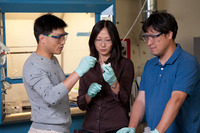 We’re reading about a group of researchers at Stanford who have concocted new gel-like substance that has some very interesting properties. We think the electrically conductive hydrogel created by Stanford Associate Professors Zhenan Bao and Yi Cui could potentially be used in 3D printers, or perhaps a modification of it. At least it’s worth an experiment or two.
We’re reading about a group of researchers at Stanford who have concocted new gel-like substance that has some very interesting properties. We think the electrically conductive hydrogel created by Stanford Associate Professors Zhenan Bao and Yi Cui could potentially be used in 3D printers, or perhaps a modification of it. At least it’s worth an experiment or two. But what are the unique properties of this substance? It’s initially a liquid that is “turned into a gel after it’s already in place”. It’s flexible and electrically conductive. The substance can also store an electrical charge. To us this sounds like the characteristics of a new kind of material one could run through a 3D printer.
A material that could enable 3D printing of electrical circuit traces embedded within a 3D object. Or 3D printing an embedded battery that precisely fits an internal cavity. This could be quite important.
We don’t know how to produce this substance, but evidently it is made from “commercially available ingredients thrown into a water solution”. No doubt this discovery will be patented as it could be highly useful to not only 3D printing but also to a wide variety of 2D electrical applications.
Via Stanford

